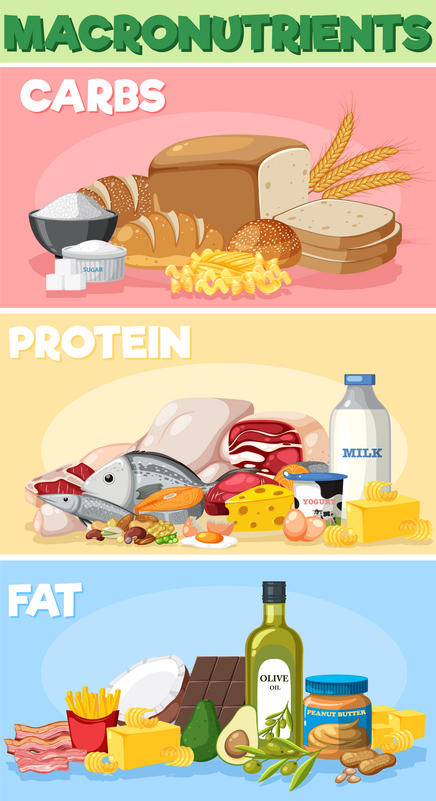What Are “Macros” Anyway?
Macros (short for macronutrients) are simply the three main components that make up the food we eat: proteins, carbohydrates and fats. Think of them as the big building blocks of your diet. Let’s break them down…
Protein: The Body’s Building Material
What Is It?
Protein is like the construction crew of your body – it builds and repairs muscles, organs, skin, hair… pretty much everything! It’s made up of smaller units called amino acids that your body uses as building blocks.
When you eat protein, your digestive system breaks it down into these amino acids, which then get reassembled into whatever your body needs at the moment. Think of it like a LEGO set being taken apart and rebuilt into something new. Whether you’re recovering from a workout, fighting off an illness, or just maintaining your everyday health, protein provides the raw materials.
Where Do I Find It?
- Animal sources: Chicken, turkey, beef, fish, eggs, dairy
- Plant sources: Tofu, tempeh, beans, lentils, chickpeas, quinoa, nuts, seeds
- Powders and supplements: Whey, pea, hemp, and other protein powders
Why Should I Care?
- Helps build and maintain muscle (especially important if you exercise!)
- Keeps you feeling fuller for longer (goodbye, constant snacking!)
- Supports your immune system (no more picking up every cold goingaround)
- Provides steady energy without crashes (4pm biscuit binge, anyone?)
A Handy Portion Guide
Aim for a palm-sized portion of protein at each meal (about 20-30g).
Carbohydrates: Your Body’s Preferred Energy Source
What Are They?
Carbs are your body’s favourite fuel! They break down into glucose, which powers everything from your brain function to your workouts. Think of carbs as the petrol that keeps your body’s engine running smoothly.
Despite sometimes getting a bad reputation in diet circles, carbohydrates are absolutely essential for optimal health and energy. Your brain alone uses about 120g of glucose per day – it’s a demanding organ that prefers carbs above all other fuels!
Where Do I Find Them?
- Complex carbs: Whole grains (brown rice, quinoa, oats), starchy vegetables (sweet potatoes, squash), beans, lentils
- Simple carbs: Fruits, milk, yoghurt
- Refined carbs: White bread, white pasta, biscuits, cakes, sweets (these lack fibre and nutrients)
Why Should I Care?
- Provide immediate energy for activities
- Fuel your brain (which loves glucose!)
- Support gut health through fibre (in complex carbs)
- Help regulate mood and sleep
A Handy Portion Guide
For most meals, aim for a cupped-hand sized portion (more if you’re very active – like a personal trainer (!) or car mechanic, less if you’re sedentary – like a computer based job).
Fats: Not the Villain They Were Made Out to Be!
What Are They?
Fats got a terrible reputation in the 80s and 90s, but nutrition science has thoroughly rehabilitated their image. Fats are essential nutrients that help with everything from hormone production to vitamin absorption. They’re the most calorie-dense macro (9 calories per gram vs. 4 for protein and carbs), which explains why they sometimes get a bad rap.
Fat performs countless vital functions in your body. It forms the membrane around every single cell, insulates nerve fibres for proper signalling, and provides the raw materials for hormone production. Without fat, your body would quite literally fall apart!
Where Do I Find Them?
- Healthy unsaturated fats: Olive oil, avocados, nuts, seeds, oily fish
- Saturated fats: Meat, butter, cheese, coconut oil (fine in moderation)
- Trans fats: Processed foods, some margarines, fried fast food (best limited)
Why Should I Care?
- Essential for brain health
- Help absorb vitamins A, D, E and K
- Provide long-lasting energy
- Keep skin, hair and nails healthy
- Make food taste delicious!
A Handy Portion Guide
Aim for about a thumb-sized portion of visible fats per meal (like oils, butter, avocado).

Finding Your Balance: It’s Not One-Size-Fits-All!
Different people thrive on different macro balances, depending on:
- Your activity level and type of exercise
- Your personal health goals
- Your individual body and how it responds to food
- Your preferences and lifestyle
Some Basic Starting Points:
For general health maintenance, a rough guideline might be 45-65% carbs, 10-35% protein, and 20-35% fat. If you’re very active or building muscle, you might adjust to 40-60% carbs, 25-35% protein, and 15-25% fat. For those focused on fat loss while preserving muscle, something closer to 30-40% carbs, 30-40% protein, and 20-30% fat might work better.
But remember – these are just starting points! The best approach is one that provides enough energy for your activities, includes foods you actually enjoy eating, and that you can maintain consistently over time.
But remember – these are just starting points! The best approach is the one that:
- Provides enough energy for your activities
- Includes foods you actually enjoy eating
- You can maintain consistently
Do I Need to Count Macros?
Great question! The short answer is: not necessarily.
Consider tracking macros if:
- You have specific performance or physique goals
- You’re trying to break through a plateau
- You’re curious about your current intake and want data
- You like numbers and find tracking motivating
Skip macro counting if:
- You find it stressful or triggering
- You prefer to keep nutrition simple
- You’re just starting your health journey
- You want to focus on food quality over numbers
A middle-ground approach:
A middle-ground approach that works well for many of my clients is focusing on including a good source of each macro at most meals. Aim for a palm of protein, a cupped hand of carbs (ideally complex ones), a thumb of healthy fats, and lots of colourful vegetables. This intuitive approach gets you most of the benefits without the potential obsession or stress of precise tracking
Beyond the Numbers: Quality Matters!
Not all proteins, carbs and fats are created equal! A chocolate bar and a sweet potato might have similar carbohydrate counts, but they affect your body very differently. Quality should always take precedence over strict numerical targets.
For proteins, choose a mix of animal and plant sources when possible. This provides different amino acid profiles and a range of additional nutrients.
With carbs, prioritise whole food sources with fibre. These regulate blood sugar better, feed beneficial gut bacteria, and provide more nutrients than their refined counterparts.
For fats, focus on mostly unsaturated sources with some saturated. Avoid trans fats where possible, as they’re the only type with consistently negative health effects.
Real-World Examples: Putting It All Together
Breakfast Ideas
- Balanced: Greek yoghurt + berries + nuts and seeds + honey
- Higher protein: Eggs + wholemeal toast + avocado
- Higher carb: Porridge made with milk + banana + nut butter
Lunch Ideas
- Balanced: Chicken salad sandwich on wholemeal bread + piece of fruit
- Higher protein: Tuna salad with mixed veg, egg and olive oil dressing
- Higher carb: Bean and vegetable soup + wholegrain roll
Dinner Ideas
- Balanced: Salmon + sweet potato + roasted vegetables
- Higher protein: Turkey chilli with beans and vegetables (light on the rice)
- Higher carb: Stir fry with plenty of veg, tofu and noodles
The Bottom Line
Understanding macros can help you make more informed food choices, but it shouldn’t overcomplicate eating. Focus on quality whole foods, include some of each macro in most meals, and find a balance that works for YOUR body and lifestyle.
Remember, no single meal defines your health – it’s your overall pattern that counts! Nutrition should enhance your life, not consume it with stress or rigid rules. Find an approach that feels sustainable and enjoyable, and you’ll be well on your way to lasting health.
🥦🍗🥑
